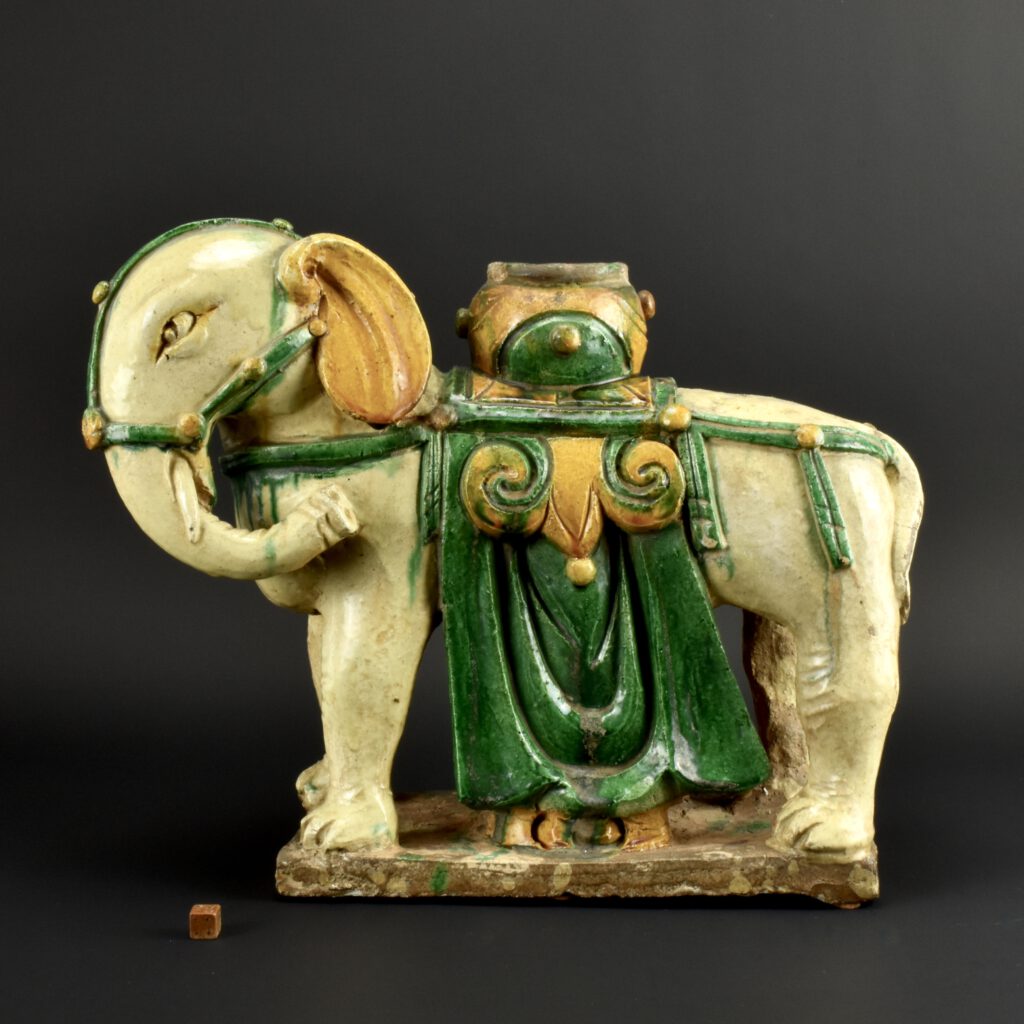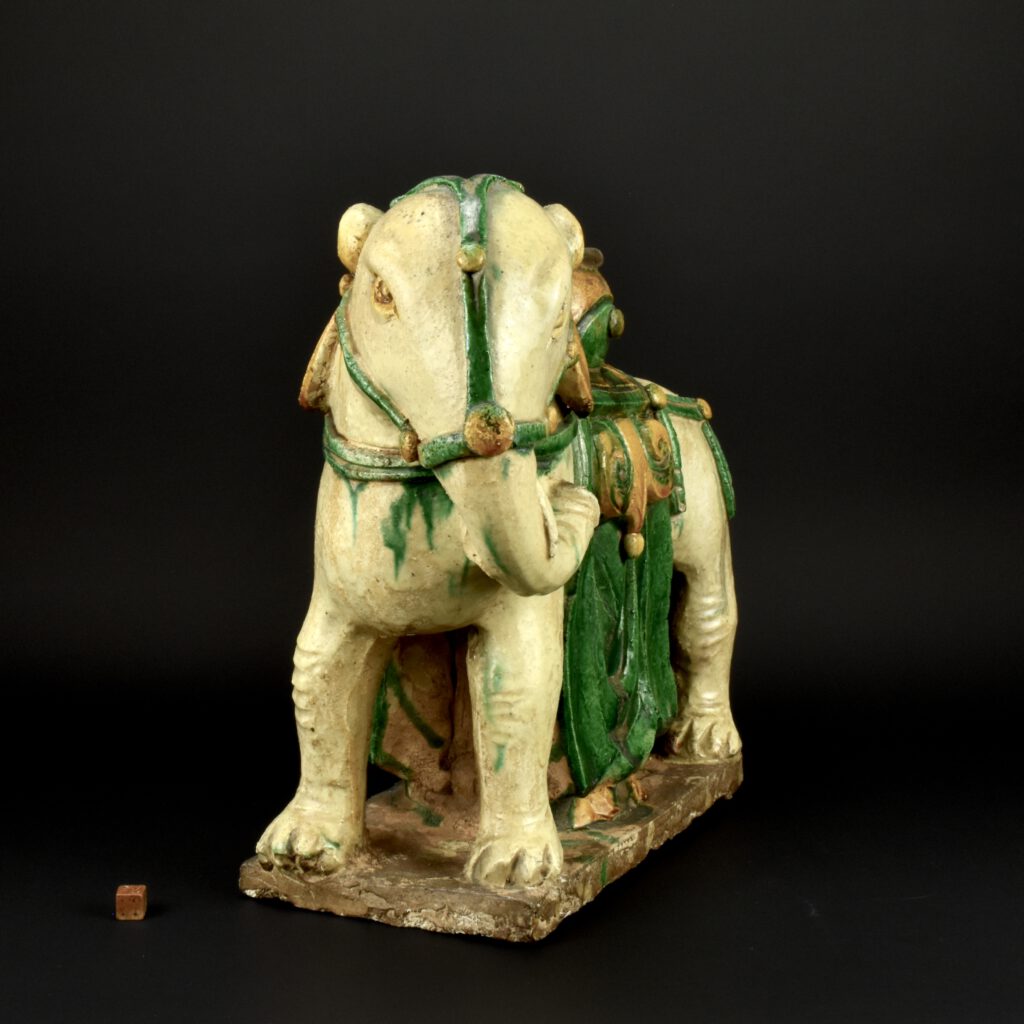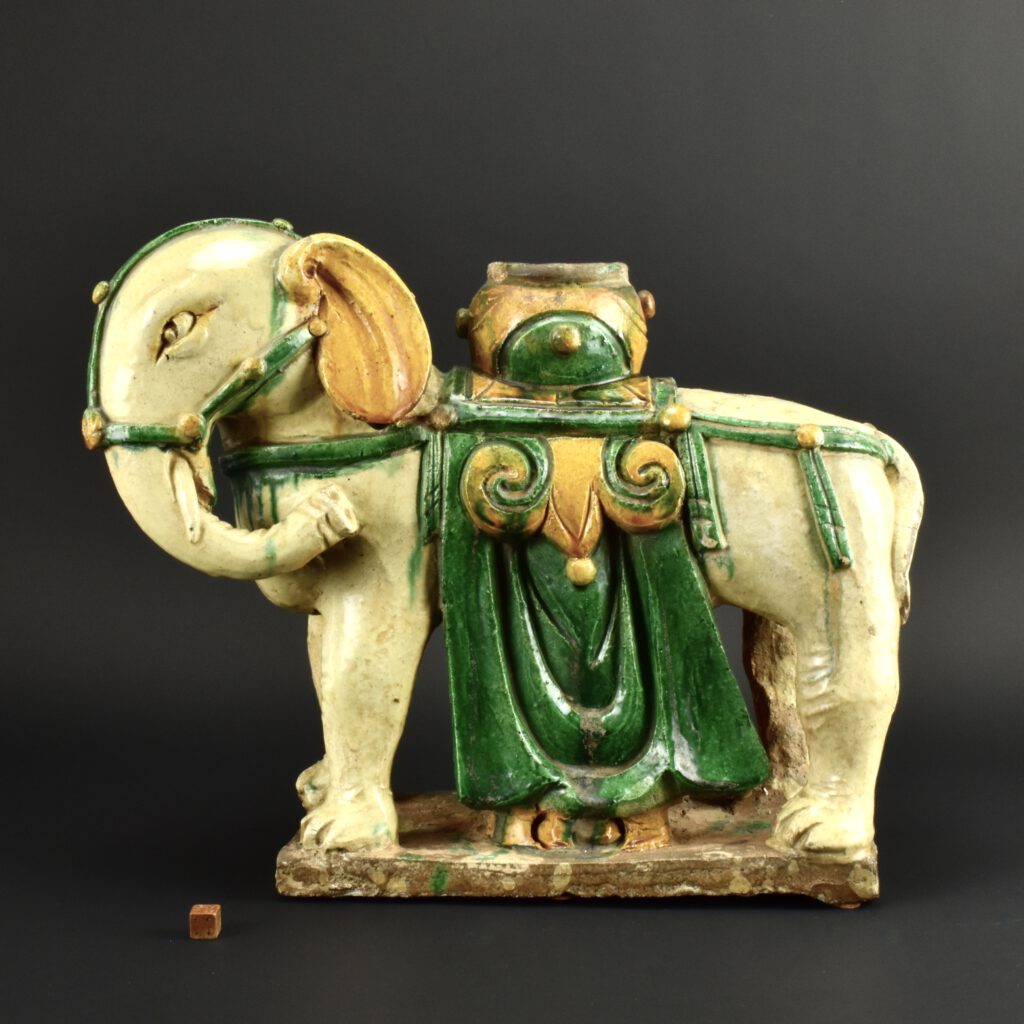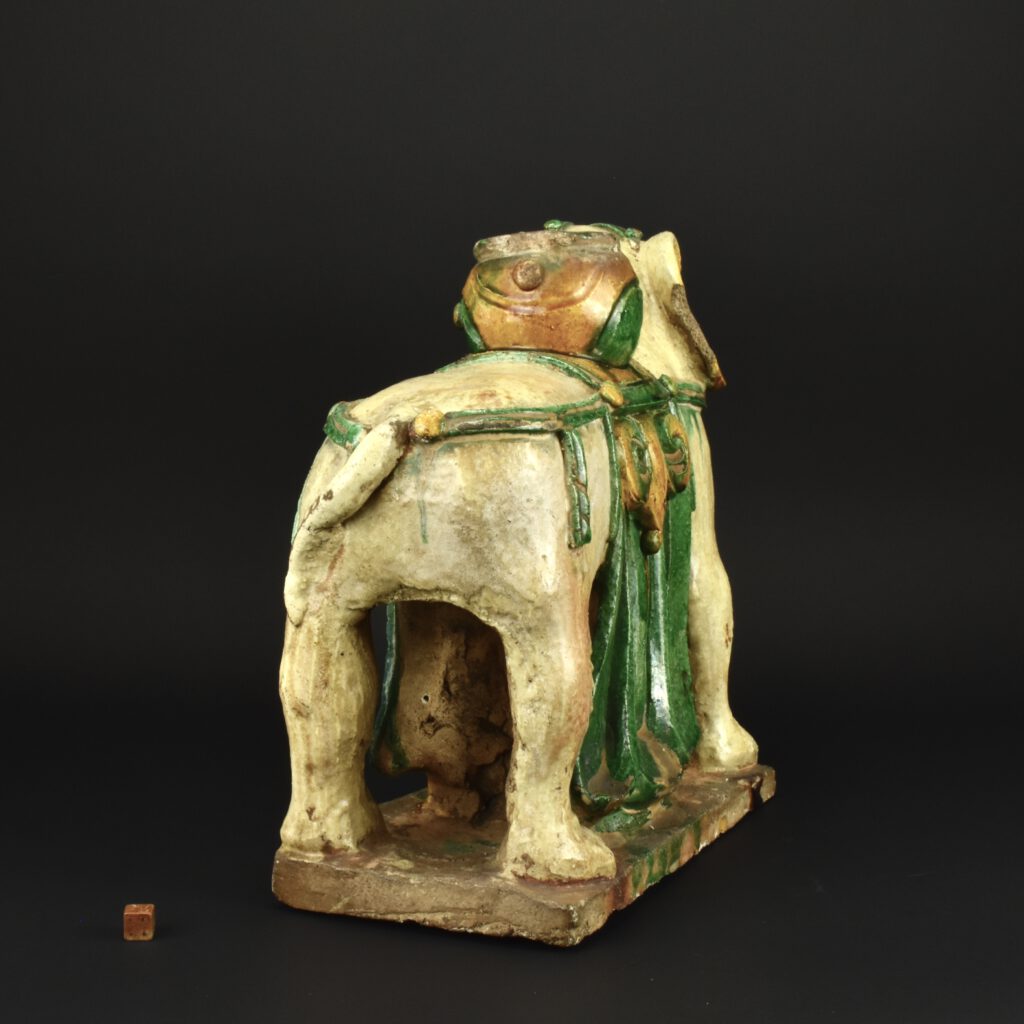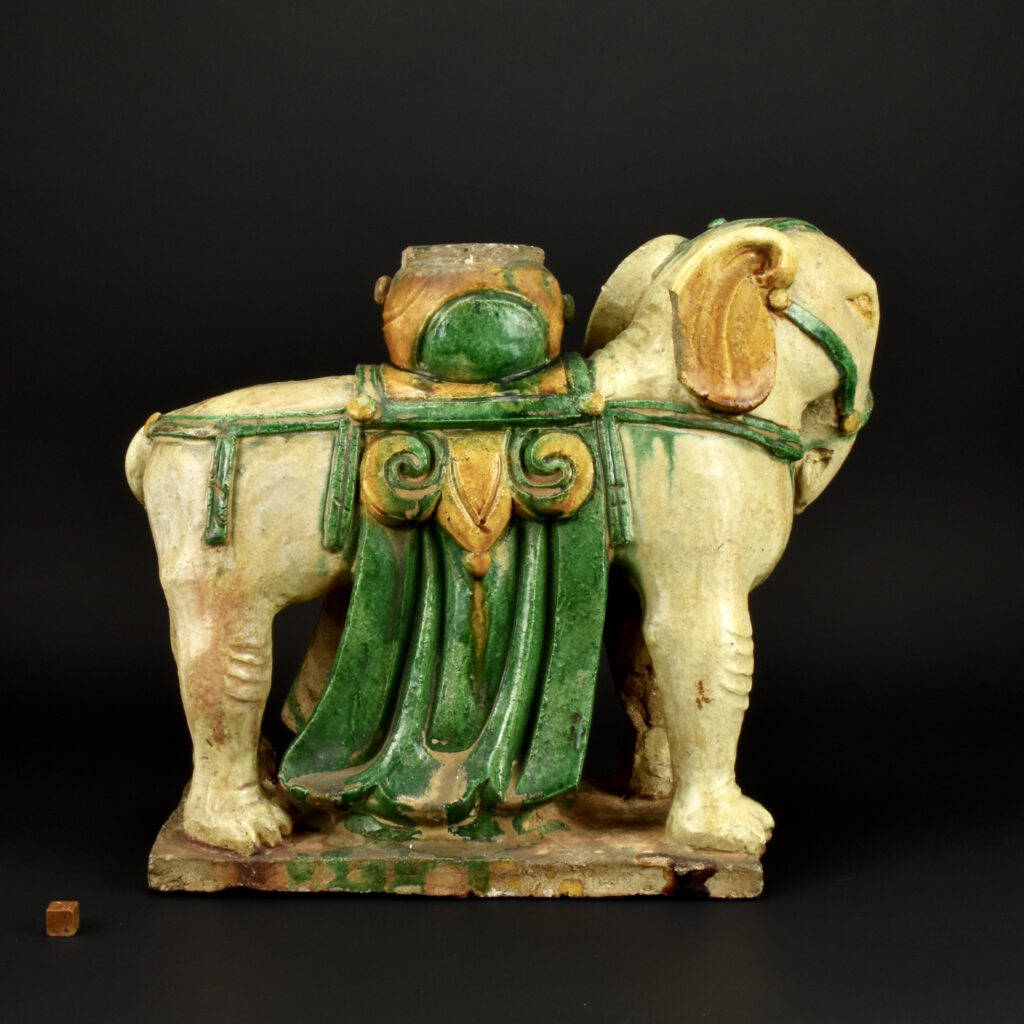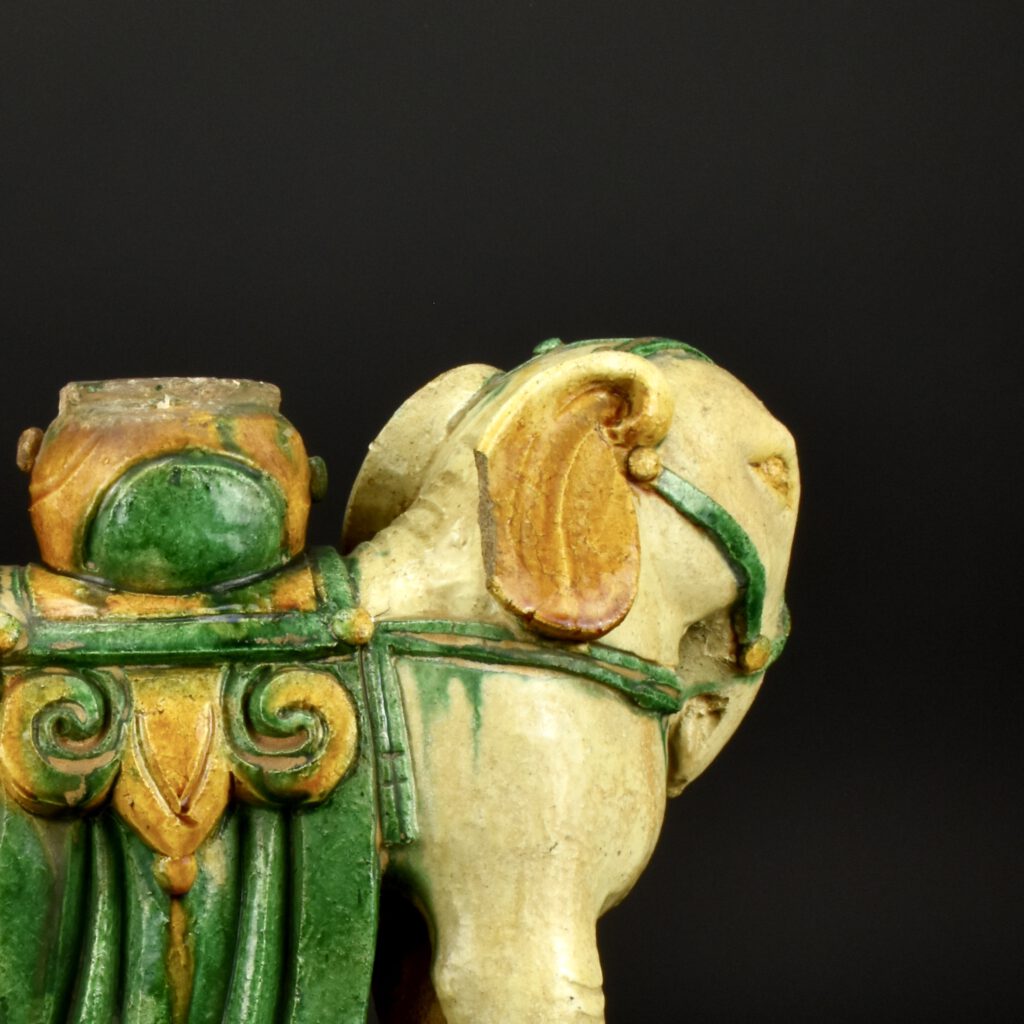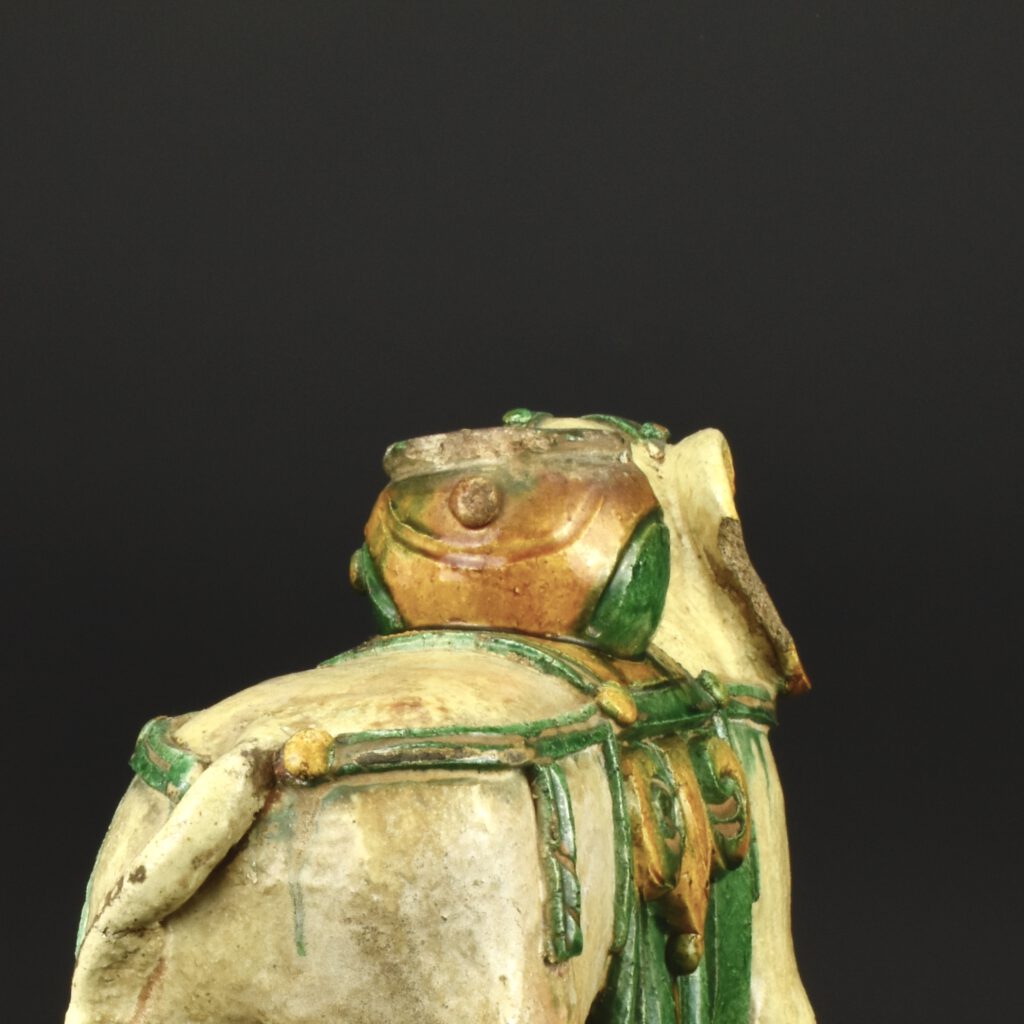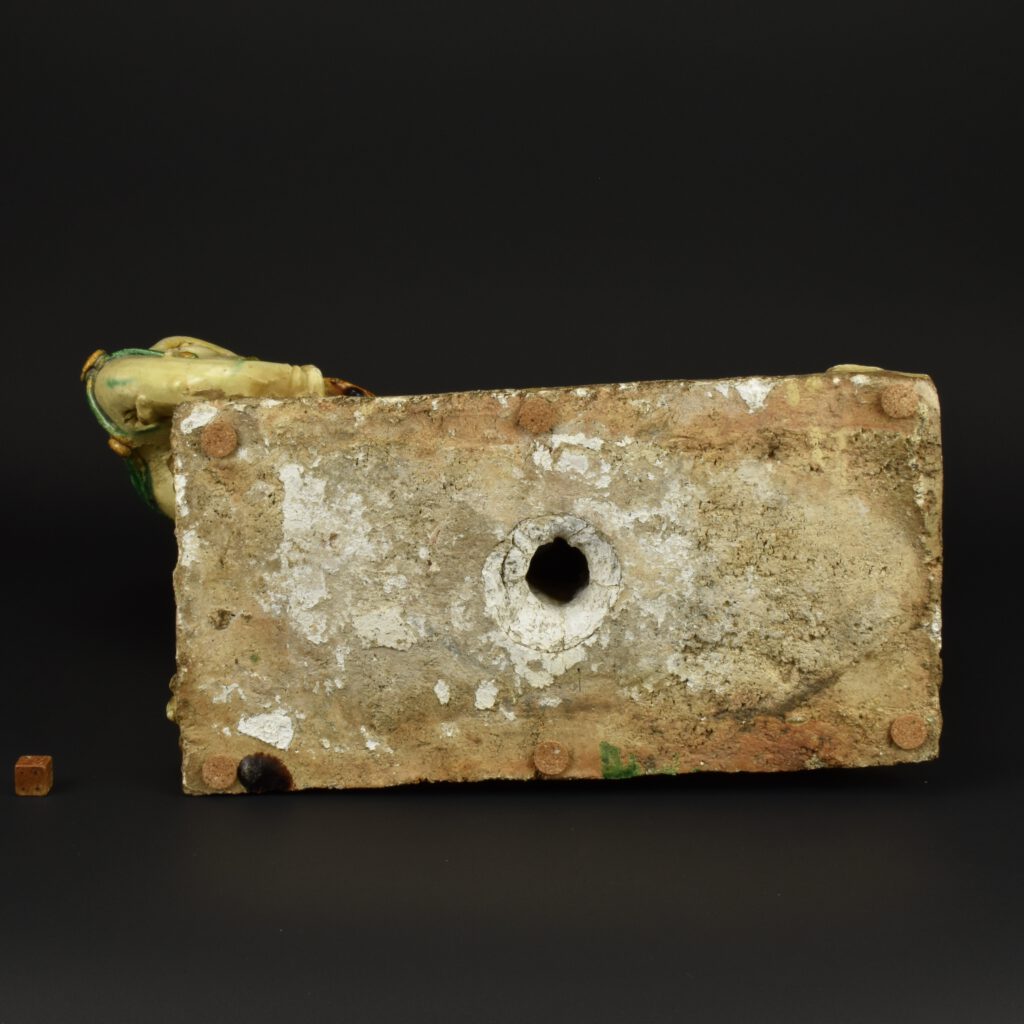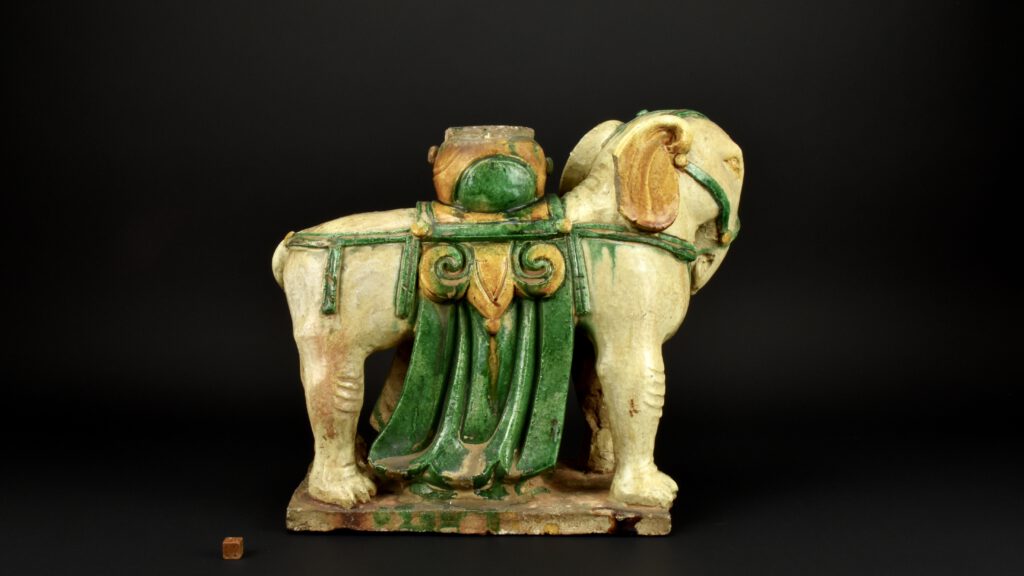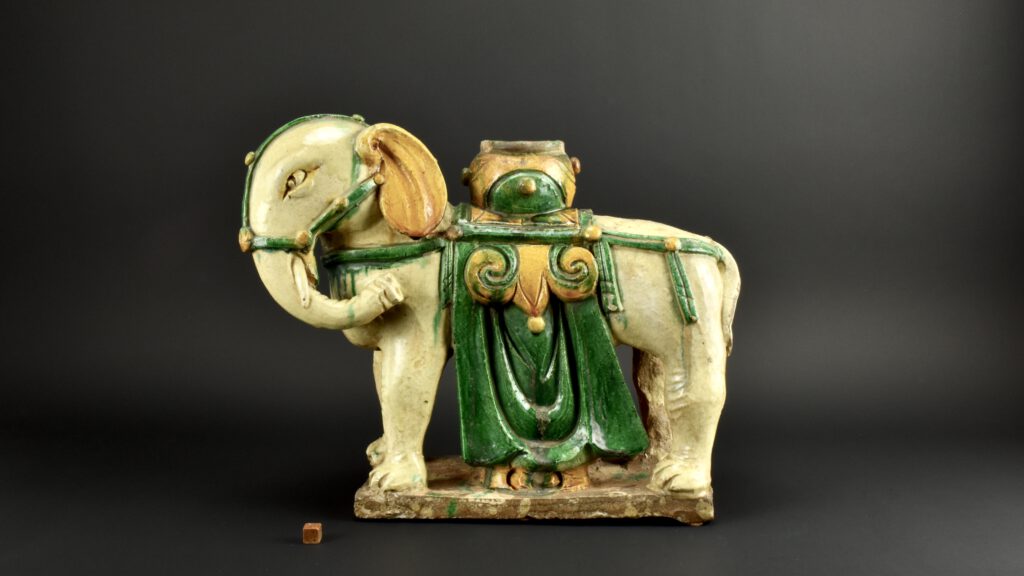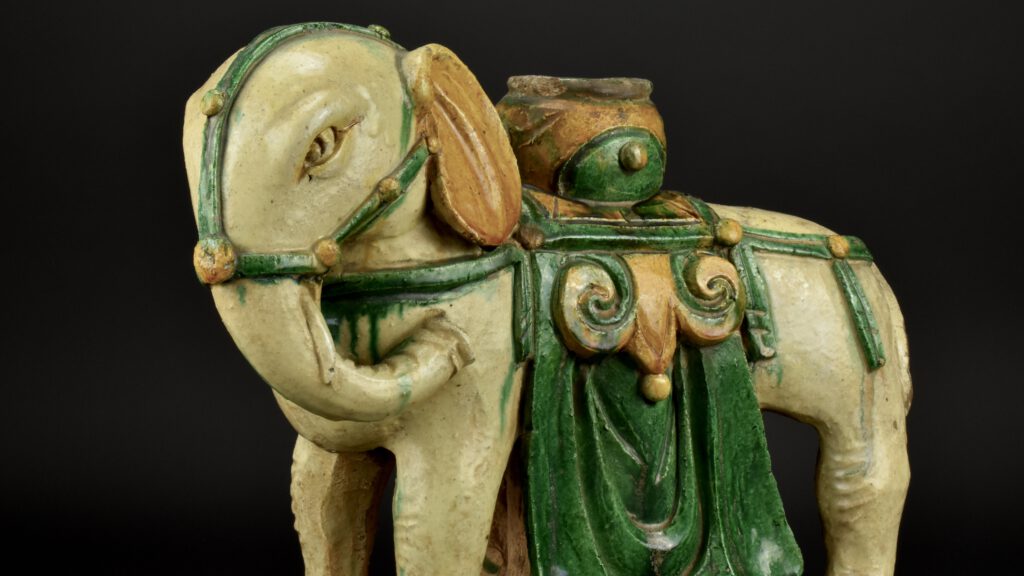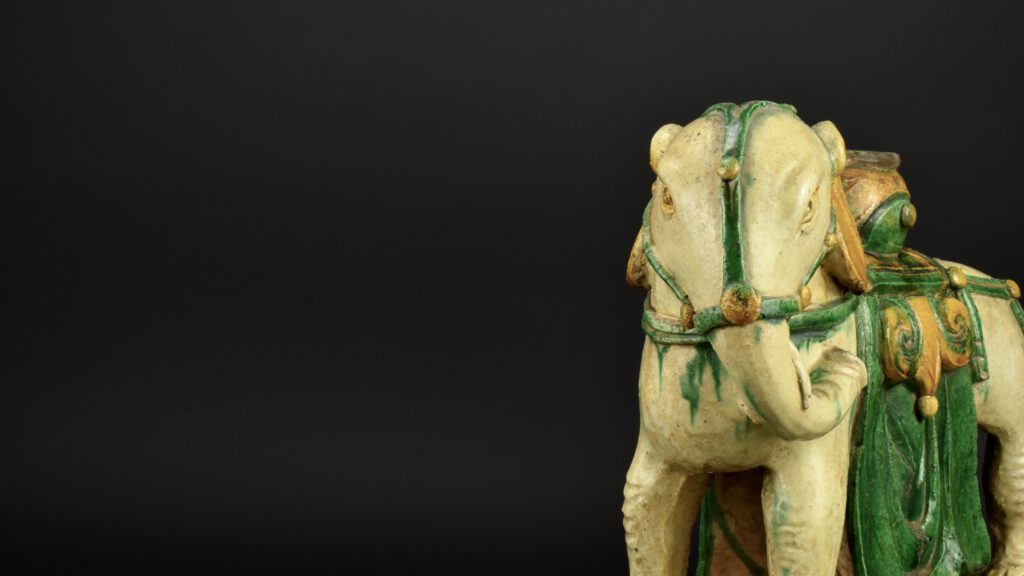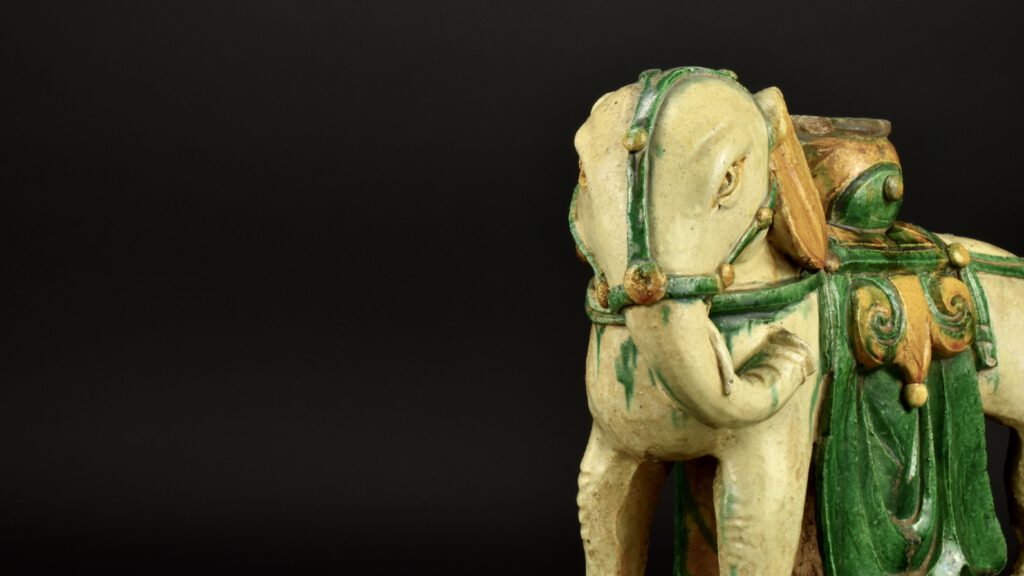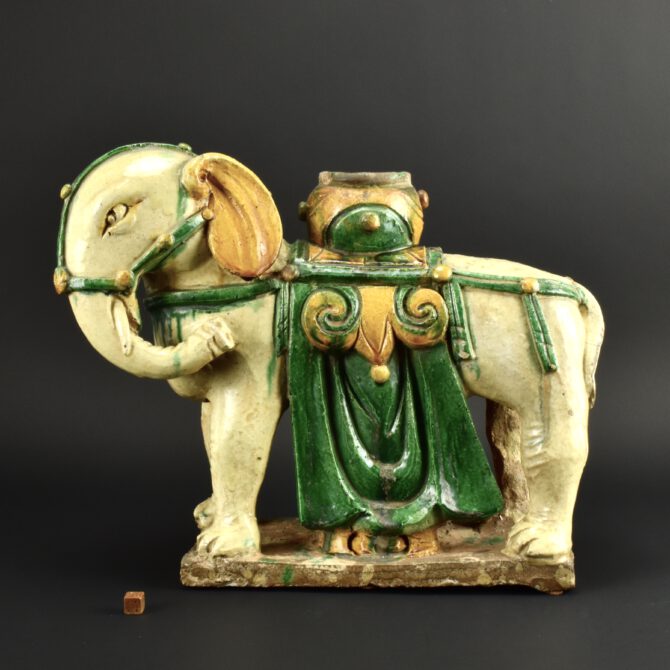
A Large Ming Lead Glazed Earthenware Elephant Form Architectural Ornament
A Large Ming Lead Glazed Earthenware Elephant Form Architectural Ornament, Ming Dynasty Jiajing to Chongzhen (1522-1644). From the Brodie & Enid Lodge collection, purchased from John Sparks on the 12th of October 1949. This substantial sculpture of an elephant is made from a gritty open textured hard earthenware and was probably made in Shanxi Province. According to traditional Chinese belief, roofs are platforms of communication between the words of the living and spirit realms. Consequently, they were decorated to ward off evil and to act as a magnet for blessings and good fortune. Xiang (elephant) is a homonym for the word happiness. An elephant with a vase forms a rebus meaning `perfect peace in the universe`, this is expanded if there is a saddle cloth to mean `perfect peace and harmony in the universe`. The elephant is also closely connected with the Buddhist religion. This Ming pottery object would have had a finial on its back, perhaps supporting an auspicious emblem, this is missing. The support for the missing finial is hollow and goes through to the flat base, there would have been an iron rod that would help connect it to the roof. There is thick white residue, this is rice glue. This is a traditional adhesive that was used in Ming architectural fittings, such as this pottery elephant. Rice glue was used as a mortar in the Great Wall of China, to this day there are sections of the Han dynasty wall where the rice is still fulfils its function after 2,000 years. There are two small drilled holes relating to a previous TL test, one in the top inside of right leg, the other at the back on the inside of the handing green fabric. There was no test result with the elephant when I purchased it, unfortunately. Perhaps it got lost or the test was inconclusive. However, with a provenance back to 1949, it can’t be a fake. The provenance is of course from experts of their day. I have had many of these Ming architectural ornaments and ridge tiles over the years and this piece is clearly genuine. For more information about Chinese roof tiles and elephants, see lower down the page. This Ming pottery Elephant weighs 10 Kilos (22 pounds in weight), so will be expensive to ship, especially to America.
See Below For More Photographs and Information.
SOLD
- Condition
- A section of the right ear is missing. This Ming pottery object would have supported a finial, perhaps supporting an auspicious emblem, this is missing. There is allot of white rice glue to the interior of this aperture, the outside rim is worn.
- Size
- Length 38.8 cm (15 1/4 inches) Height 32 cm (12 1/2 inches)
- Provenance
- From the collection of Brodie & Enid Lodge, Flore House, Northamptonshire. The Brodie Lodge archive lists no.F21 as purchased from Sparks on the 12th October 1949. Brodie lodge label F21, and a tiny fragment of a John Sparks label.
- Stock number
- 27332
- References
- A similar but damaged Ming Elephant shaped architectural ornament is in the Victoria and Albert Museum, London. For a photograph and details see lower down on this page.
Information
A Related Ming Elephant Form Architectural Ornament
On Display at the Victoria and Albert Museum, London.
https://collections.vam.ac.uk/item/O180713/figure-of-elephant-unknown/#object-details
![Purchased from S. M. Franck & Co. (Mr. Wylde's Purchases in China), accessioned in 1912. This acquisition information reflects that found in the Asia Department registers, as part of a 2022 provenance research project.This figure was acquired in Beijing. Mr Wylde's purchases in China on behalf of Messrs. S.M. Frank & Co., 25 Camomile St. EC. The museum purchased the lot for £3 17s. 1d. [C.365 to 43-1912] In 1912 C.H. Wylde, the first Keeper of Ceramics and first member of V&A staff to visit East Asia, acquired architectural fittings and fragments from China.](https://orientalceramics.com/wp-content/uploads/2024/09/2006BD7832-300x298.jpg)
This figure was acquired in Beijing.
Mr Wylde's purchases in China on behalf of Messrs. S.M. Frank & Co., 25 Camomile St. EC. The museum purchased the lot for £3 17s. 1d. [C.365 to 43-1912]
In 1912 C.H. Wylde, the first Keeper of Ceramics and first member of V&A staff to visit East Asia, acquired architectural fittings and fragments from China.
A Ming Cizhou Stoneware Elephant
Robert McPherson Antiques - Sold Archives - 26661.
From the Collection of Nicholas de la Mare Thompson (1928-2010).
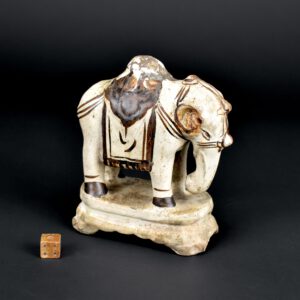
Ming Pottery Roof Tiles /Liuli Wa :
According to traditional Chinese belief, roofs are platforms of communication between the words of the living and spirit realms. Consequently they were decorated to ward off evil and to act as a magnet for blessings and good fortune. Marco Polo was struck by the visual effect of these brightly coloured tiles, remarking while describing Khubilai Khan`s palace at Dadu (modern day Beijing) The roof is all ablaze with scarlet and green and blue and yellow and all the colours that are, so brilliant varnished that it glitters like crystal and the sparkle of it can be seen from far away. The Chinese had made ceramic tiles from early times but it was the Ming dynasty that saw the largest period of production, much of this was based in Shanxi Province at small family run kilns that passed down from generation to generation. Glazed tile-work is known in China as Liuli Wa, literally `roof-tile of glass`, a term dating back to the Tang Dynasty (618-906) although Tang tiles are now very rare. The soft earthenware used to make Ming tiles varies but often is uneven in its constitution with lots of grog. The tiles were mould made with a large amount of hand working, giving a completely hand-made look with lots of sharp detail and undercutting. They were lead glaze and low fired which means the glaze often runs. There were two basic colour schemes used Sancai (greens,yellows and browns) and the darker palette of Fahau (turquoise, blue and purple). The dating of Chinese glazed tiles, which were made over a long period of time with little change, is difficult. Knowing when the building they came from was build doesn`t help as tiles, exposed to the elements, needed replacing from time to time and so a building might contain tiles made over several centuries. However an approximate chronology can be understood, and with the study tile construction replacements can be identified as being different to the genuine Ming examples.
Elephants / Xiang :
Although symbolically important the elephant is not commonly depicted on Chinese ceramics. When it is the depiction, unlike so many animals, it can look unreal and rather odd. Presumably this is because the ceramic artist would have been unfamiliar with an animal, their numbers became diminished and were limited to certain areas of the country. It is thought that China`s elephant population is only in the region of 300 today. The Asian Elephant (Elephas Maximus) is sometimes depicted on Chinese ceramics as an animal with a rounded back and with loose fitting skin, but it can be shown as a powerful animal decked in rich cloth and carrying a vase on its back. Like so many other Chinese symbols the meaning it conveys is connected with the pronunciation of the word. Xiang (elephant) is a homonym for the word happiness. A rebus is formed when an elephant is depicted with a rider, usually a child, this conveys a `wish for happiness`. An elephant with a vase forms a rebus meaning `perfect peace in the universe`, this is expanded if there is a saddle cloth to mean `perfect peace and harmony in the universe`. The elephant is also closely connected with the Buddhist religion. An uncommon but interesting image of an elephant can be found on a few pieces of blue and white porcelain from the Transitional period. These scenes depict the Buddhist ritual of washing an elephant. For a Transitional blue and white brushpot dating to c.1640 with a version of this scene see : Late Ming, Chinese Porcelain from the Butler Family Collections (Exhibition catalogue, Sir Michael Butler, Musee National d`Histoire et d`Art Luxembourg 2008. ISBN 978-2-87985-029-0) page 125, plate 86. Another blue and white porcelain Transitional brushpot shows a boy with a brush cleaning the elephants back, see : Seventeenth-Century Blue and White Porcelain and Copper-Red and Their Predecessors (Exhibition Catalogue, S Marchant & Son, London, June 1997) page 53, plate 30.
